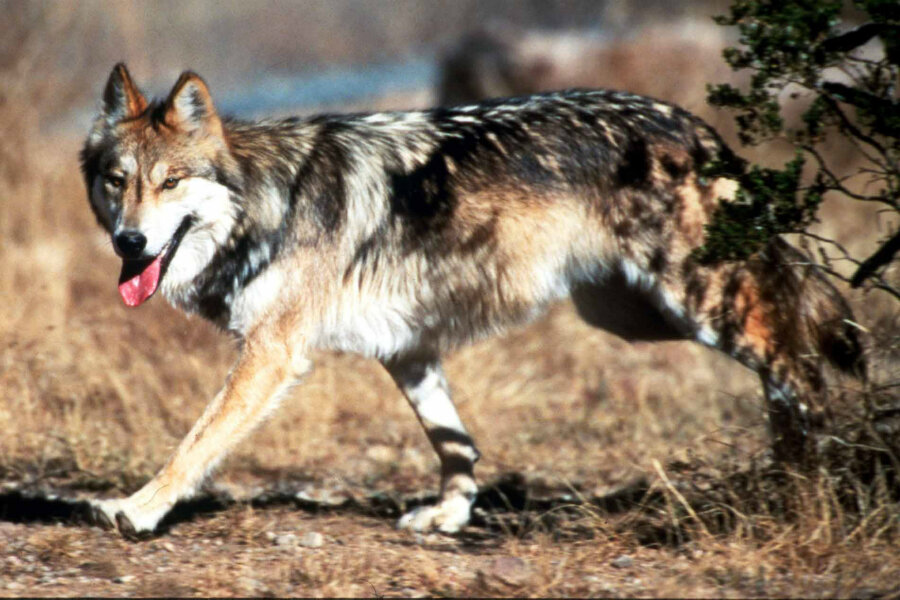Suspicion over federal wolf plan spreads to Colorado, Utah
Loading...
| Denver
Suspicion over federal plans to restore endangered Mexican gray wolves in the Southwest has spread to Colorado and Utah, where ranchers and officials are fiercely resisting any attempt to import the predators.
About 110 Mexican gray wolves — a smaller subspecies of the gray wolf — now roam a portion of Arizona and New Mexico, nearly two decades after the US Fish and Wildlife Service released 11 wolves there to restart a population that had nearly vanished.
The agency hopes to complete a comprehensive recovery plan for the Mexican wolf in 2017, and officials say they've made no decision about releasing them in Colorado or Utah.
But neither state is waiting. Their governors joined Arizona and New Mexico's executives in November to accuse the Fish and Wildlife Service of using flawed science and biased experts. They demanded that no Mexican wolves be released outside the southern parts of Arizona and New Mexico.
Wildlife commissioners in Utah and Colorado also spoke out against releasing Mexican wolves in their states — the Utah Wildlife Board in December and the Colorado Parks and Wildlife Commission last Wednesday.
The Fish and Wildlife Service defended the experts and the process.
Mexican wolves have been contentious in Arizona and New Mexico for years. New Mexico officials are resisting proposals to release more wolves. Arizona state lawmakers tried but failed to allow ranchers to kill federally protected wolves in self-defense.
Environmental groups, meanwhile, are pushing for the release of more captive-bred wolves to bolster the population in those states.
In Colorado and Utah, opponents argue that wolves would inflict costly and cruel losses on cattle and sheep and decimate big game herds that support the lucrative hunting industry. They also say Mexican wolves aren't native to their states, and bringing them in could taint the gene pool if they bred with gray wolves roaming down from the northern Rockies.
"We don't need to introduce another large predatory carnivore to the state," Colorado Wool Growers Association director Bonnie Brown told the Colorado Parks and Wildlife Commission last week. Mountain lions are already killing pets in urban areas bordering open country.
Wolf advocates say the fears are overblown, and that Mexican wolves need more ranges to avoid extinction. Parts of Colorado and Utah would be ideal for wolves, said Jonathan Proctor of Defenders of Wildlife, and he argued that both states are within the wolves' historical range.
The West needs wolves to help restore balance to the environment, he said.
"It's we humans who have eradicated all the wolves from the West," Mr. Proctor said. "It's our responsibility to bring this animal back."
Wolves have long been deeply divisive subject in the region. They were hunted, trapped or driven out of many areas by the end of the last century and were regarded as a menace to largely defenseless sheep and cattle. But they also became a symbol for the environmental movement, a noble if fearsome avatar of the wild.
To support their arguments, both sides point to the northern Rockies, where the Fish and Wildlife Service estimates about 1,800 gray wolves live in Idaho, Montana, Oregon, Washington and Wyoming.
Wolves began killing hundreds of sheep and cattle after their release in the northern Rockies about 20 years ago, and big game populations fell drastically in some areas, officials said.
But they say cattle deaths are declining and game herds are rebounding since wolves were removed from Endangered Species Act protection in Idaho and Montana in 2011. The Fish and Wildlife Service then turned over wolf management to the states, which allow some hunting and sometimes remove or kill problem wolves.
"We know the wolf population is doing fine and continues to expand," said Mike Jimenez, northern Rockies wolf coordinator for the Fish and Wildlife Service. "We use lethal control on wolves that are causing big problems."
Overall agricultural losses are low, but to an individual rancher, they can be devastating, he said.
In Idaho, elk numbers have begun to rebound since the state began managing wolves, state Fish and Game spokesman Mike Keckler said.
"And we still have a very sustainable wolf population in our state," he said. "So we feel like we're making progress in bringing balance."
Wolves were briefly removed from federal protection in Wyoming, but safeguards were restored after environmental groups filed lawsuits challenging state management plans. The state is appealing the decision.
Legal wrangling is part of what makes wolves so aggravating, said Jim Magagna, executive vice president of the Wyoming Stock Growers Association.
"We have learned to live with them," he said of the estimated 330 wolves in Wyoming. "We have not learned to live with the never-ending process."







